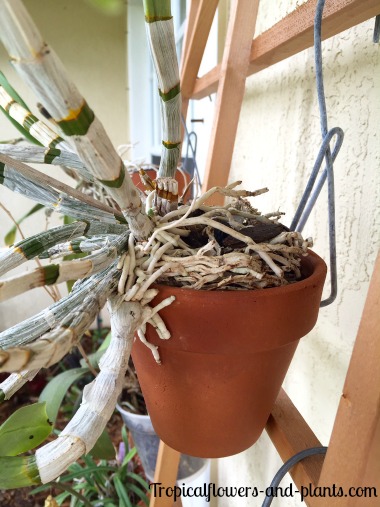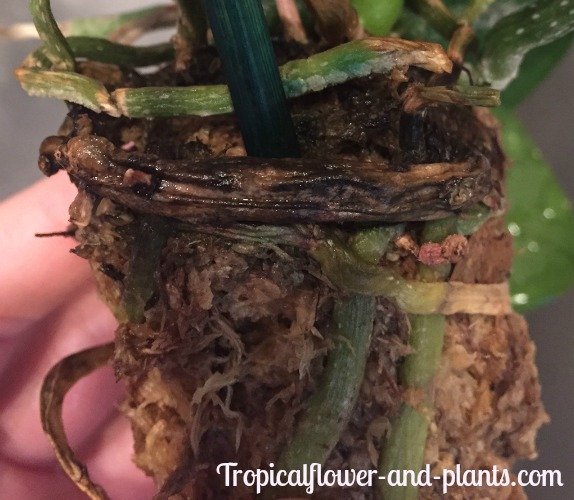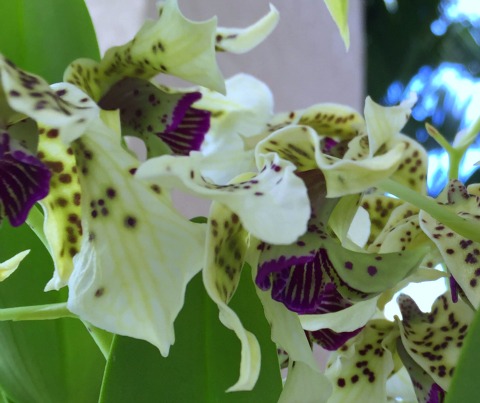|
|
Dendrobium
Orchid
Dendrobium orchids are considered epiphytes or air plants that grow upright. These tropical flowers come in a variety of colors and their flowers size will range from 1-2 inches. It is not uncommon for the orchid to re-bloom from previous canes. The stems are referred to as “canes” due to their segmented structure. I have even heard some refer to the canes as bamboos. Dendrobium orchids that contain a large amount of canes may produce blooms almost all year long. When your orchid begins to bloom you may want to remove the orchid from any direct sunlight to help prolong the beautiful flowers. Remember once the flower dies remove the flowers steam at the location it grew from. The leaves will grow on the upper part of the cane leaving the lower half of the cane bare.
TIP: If you see a leaf that is turning colors remove that leaf.
This is one of my favorite orchids from my collection!!!!! I love how it hangs upside down. The first thing you will notice, beside the flowers petal positions, is the black freckles that cover the flower. However, that isn't the best part..... underneath those petals a deep purple covers the lip which can be seen poking through the petals in certain angles. I'm sure you can see why I love this orchid so much. It is beyond unique!
This is a general overview on how to care for your Dendrobium orchids. There is a vast variety to pick from so before purchasing your orchid make sure to ask questions on that specific one. The needs may fluctuate slightly
Light
This tropical flower requires bright light to some direct sunlight throughout the year. Make sure the light source is coming from directly above to continue the orchid’s growth in the upward position.
I have several Dendrobium orchids that hang from larger trees. This allows the orchid to have that occasion direct sunlight through the leaves. It also makes my backyard look tropical during the blooming months.
Planning on growing this beautiful orchid indoors you will need to have a window that faces east or west. This will provide it will enough light. In my personal experience I haven't had much luck growing them indoors.
Temperature
Dendrobium orchids grow best with temperatures averaging 58 degrees at night to 85 degrees during the day. On the plus side, this particular orchid’s temperature range is very similar to your home temperature. No special modifications for them.
Humidity
Orchids in general love the humidity, so it’s no surprise that Dendrobium orchids fall in this category. They like a reasonably humid climate of 50 percent or greater.
If the tropical flower is growing outside and your going through those dry months you may need to spray them to create that humidity.
Growing your Dendrobium inside may require you to pay more attention to the humidity. You will need to increase the levels of the humidity around the orchid. To achieve this you may need to spray your orchid in the mornings and add a humidity tray.
Watering
During your orchids active growing months make sure to keep it evenly moist. Watering your orchid once a week should be enough however some months you may need to water these tropical flowers more or less.
Keep in mind that how often you may need to water depends on the size of the pot, the medium that was used and the temperature.
Fertilizer
Fertilizer should be given to the tropical flower during the orchid’s active growth. You want to give them a fertilizer of 20-20-20 or a similar balance.
Now….. That doesn’t mean that if you don’t give it fertilizer it will die! Trust me my orchids have gone without it.
Make sure you read the directions on how much fertilizer to give to your orchid.
TIP......Purchasing your orchid at a nursery you can ask them what they use and how often. This will help keep the regimen up.
Repotting
In the orchid trade I have heard so many different techniques on how and when to repot your orchid. Over all the recommended time to repot your Dendrobium is every 2-3 years. This does not mean that you couldn’t repot sooner.
Here are some of the indications on when you should repot:
1) The roots of the orchid have begun to grow/ protrude over the edge.
2) The medium has begun to breakdown and the water drainage is weak.
3) The orchid’s roots are completely root bound.
 |
No Judging!!!! This poor guy needs to be re-potted badly!!! |
If you are planning on re-potting your orchid make sure you do it after your orchid has bloomed. Make sure the pot is not too large but large enough to allow 2-3 years of growth.
Before re-potting my Dendrobium orchid I will decide on two things:
1) Divide the tropical plant.
2) Keep it all together and have one huge orchid. Which can always bring lots of attention when in bloom.
Dividing Your Orchid... can only occur if you have enough pseudobulbs (also known as canes)
1) Each division of the tropical plant should include a minimal of 4 canes. Some orchid growers like to divide them with 6-10 canes.
TIP: Make sure the 4 canes have healthy looking leaves. Healthy leaves will aid the orchid in future growth.
2) Inspect your orchid for a natural division line. This simple means that you want equal sizes of pseudobulbs for each division.
3) With a clean knife (always use a clean tool to prevent any spread of viruses among plants) cut down the division line. You will cut through the rhizomes and the root mass.
TIP: When making your cut try and keep as much of the root mass as possible. This will help with the orchids transplant shock.
4) At this point you can now clean up any dead roots or leafless canes.
Re-Potting Your Orchid.....
1) Pick out the new pot (pot should contain holes at the bottom for water drainage) your Dendrobium orchids will go into. Make sure you have enough growing room for the next 2 years.
TIP: Generally the new pot should increase by 1-2 inches. These particular orchids love to stay close even after re-potting them.
2) Place the orchid in the new pot while adding the potting orchid mix around the roots. You want to make sure the roots are covered about 1 1/2 inch beneath the potting mix.
3) Pack down the orchid mix to insure that the orchid is secure in its new home. To add a little more security you can place a small stick inside and clip one of the canes to it.
4) After about a week give your Dendrobium orchid a nice soak.
 |
Notice the brown and shriveled roots. Those are the ones you want to cut off. |
Some of these porducts may help you in your transplanting needs.
TIP: Always have extra in case something goes wrong.
|
I love using clear containers during my orchid transplant! They offer several benefits to not only myself but my orchid. 1) I can see how the roots are growing. 2) With the clear plastic the sun is able to reach it faster. Drying up all the excess water. |
If you love this specific type of orchid check out this page for some more pictures.......






New! Comments
Leave me any questions and comments in the box below.